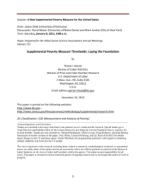
An official website of the United States government
Here’s how you know
Official websites use .gov
A .gov website belongs to an official government organization in the United States.
Secure .gov websites use HTTPS
A lock (
) or https:// means you’ve safely connected to the .gov website. Share sensitive information only on official, secure websites.
-
//
- Census.gov /
- Census Working Papers /
- Supplemental Poverty Measure Thresholds: Laying the Foundation
Supplemental Poverty Measure Thresholds: Laying the Foundation
Supplemental Poverty Measure Thresholds: Laying the Foundation
Abstract
Guidelines to produce a poverty measure for the U.S. are included in a document, Observations from the Interagency Technical Working Group on Developing a Supplemental Poverty Measure (SPM), released early in 2010. These guidelines are based on recommendations released in 1995 in a National Academy of Sciences Panel report edited by Citro and Michael (1995). The Interagency Technical Working Group (ITWG) went further than the NAS Panel and recommended that separate thresholds be produced by the housing status of families. Additional changes included expanding the reference family to include all household units with two children rather than those composed of two adults with two children only, and to use the 33rd percentile rather than the median in the threshold calculation. A purpose of this research is to present the guidelines for the development of SPM thresholds and to lay the foundation for the estimation of the SPM thresholds at the Bureau of Labor Statistics (BLS). The Panel used three years of U.S. Consumer Expenditure Interview Survey data for the thresholds. However, in this study, five years of data are used to produce SPM thresholds. Due to differences in the number of people in the reference sample, an equivalence scale adjustment is applied to expenditures including the value of in-kind benefits. To produce thresholds for comparison, the equivalence scale is applied to the distributional results to produce thresholds for two adults and two children. Data collected in 2004 quarter two through 2009 quarter one are used to produce SPM thresholds for 2008.
All of the SPM thresholds are lower than the NAS threshold and higher than the official poverty threshold with one exception. The SPM threshold for owners without a mortgage is lower than the official threshold for 2008 and is the lowest of the three housing status thresholds. SPM thresholds for owners with mortgages are the highest, followed closely by those for renters. The means, distributions and thresholds presented in this study are preliminary. Standard errors have not been produced; thus, differences are discussed in relative rather than statistical terms.
Share
Related Information
WORKING PAPER
Supplemental Poverty Measure Working PapersSome content on this site is available in several different electronic formats. Some of the files may require a plug-in or additional software to view.
 Yes
Yes
 No
NoComments or suggestions?


Top

